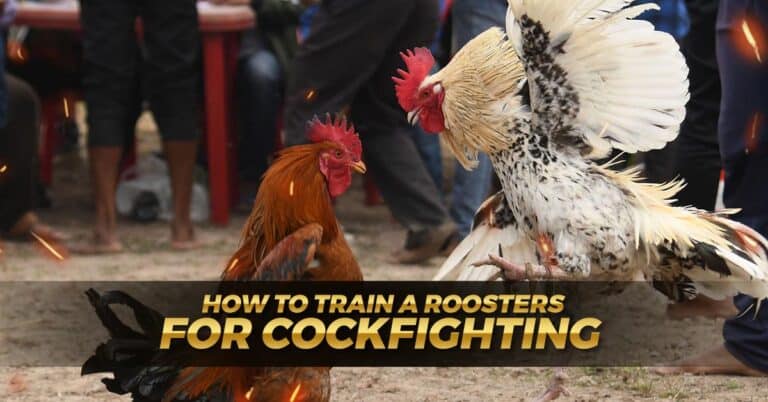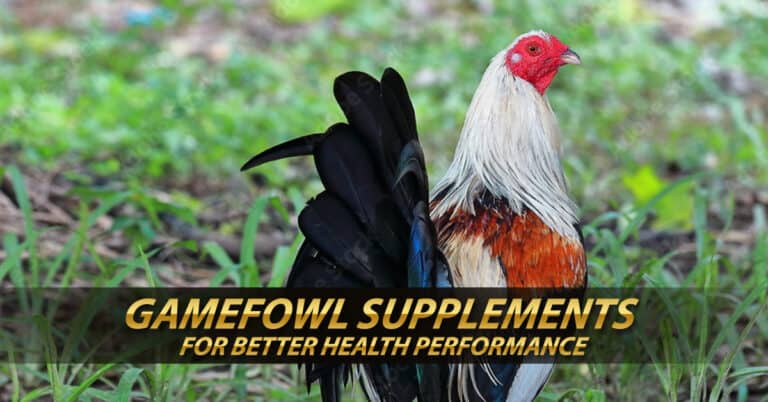Familiar Gamefowl Diseases and Treatment
Diseases are common in gamefowl, and that’s why they need a gamefowl vaccination program. Other birds on the farm can readily contract several diseases, which leads to the main issue: infestation. When this occurs, the repercussions could seriously affect the breeder and result in financial loss. Early knowledge of the most prevalent gamefowl diseases and effective methods of prevention is crucial for preventing this. Continue reading to learn more.

Respiratory Diseases
Identify the respiratory condition that is causing chicken wheezing.
It is crucial to treat your chicken right away if it gets a respiratory infection because recovery without treatment is extremely unusual. Additionally, if the infection is not treated swiftly, it could spread to the other birds in your flock.
The Detection of Respiratory Gamefowl Diseases
Your chicken’s sneezing could be a sign of a major health issue. Wheezing, coughing, sneezing, and breathing difficulties are all cold-like symptoms that should not be ignored.
In actuality, hens do not get the common cold or the flu, unlike humans. Sneezing or wheezing symptoms in poultry are caused by a bacterial infection known as Chicken Respiratory Disease (CRD). When exposed to Mycoplasma gallisepticum (CRD bacteria), a healthy chicken can resist the germs; however, if it is subjected to one or more environmental triggers, this will decrease its immune system and the disease will start to spread. Among the most frequent environmental triggers are:
Chicken respiratory illness symptoms
Chicken respiratory diseases, and CRD in particular, have the propensity to progress gradually. Early diagnosis of the infection may be crucial to a successful recovery. Therefore, it is crucial to keep an eye out for illness in your flock.
Your chickens may exhibit the following symptoms of a respiratory illness:
Listen to your chicken’s chest if you suspect it might be suffering from a respiratory condition. It’s likely that when they breathe, you will hear a rattling, congested (phlegmy) sound.

How to deal with respiratory illnesses in chickens
Since chicken respiratory sickness is an infection, medical attention is necessary. CRD will eventually result in the death of healthy birds if left untreated. Take the following actions to treat a chicken respiratory infection:
1. Separate the illness
Due to the quick transmission of infectious diseases within your flock, chickens are gregarious animals. To protect the remainder of the flock, unwell birds must be isolated as soon as possible. This entails giving the afflicted birds their source of food and water.
2. treatment of sick birds
The three main factors that will aid in a chicken’s rehabilitation are warmth, food, and water. Water intake should be given special attention. It might be required to use a spoon or dropper to administer water to the ill bird if the CRD is severe. Until the bird is fully recovered and able to drink on their own, this care may be required.
3. Get Rid of the Infection
CRD, which is brought on by the bacterium Microplasma gallisepticum, is the most common respiratory ailment in hens. Laryngitis, bronchitis, tracheitis, and even pneumonia are common conditions that also need to be treated the same way.
We advise using a broad-spectrum antibiotic suited for hens. You can buy antibiotics for poultry over-the-counter or you may want to speak with a veterinarian. For optimal effects, take a course of probiotics like 2 Pak Avian Probiotic after taking antibiotics.
In cases where the infection is not extremely severe, it may also be able to treat CRD naturally. It’s frequently advised to use VetRx Poultry Remedy to treat chickens’ respiratory diseases.
4. lowered the potential for re-infection
To stop the spread of disease, proper coop management is crucial. To lessen the chance of reinfection, carefully clean the coop after any illness. VetRx Poultry Remedy can be used as a prophylactic to lower the risk of bacterial illnesses in addition to treating CRD and other infections.
Chicken Health For Dummies is a fantastic resource on the prevention, diagnosis, and treatment of illness and disease in the chicken coop and is another must for chicken keepers.
5. Gamefowl Vaccination Program
Similar to people, vaccination is crucial to preventing several diseases that can harm your gamefowl’s health and performance. However, gamefowl vaccination can be incredibly intimidating and confusing if you’re new to the field. Read on for a quick overview of the pertinent details, a sample vaccination schedule, and a list of vaccination administration techniques.
Gamefowl Vaccination Program Types
When reading about and researching the gamefowl vaccination program, the terms live vaccine, attenuated vaccine, and dead vaccine are likely to appear. Because these vaccines are various types of vaccines, they must be handled and delivered in different ways.

Live vaccination
A vaccine is said to be live if live microorganisms are the main component. Because the bacteria is likely to cause illness and some aches, live immunizations are normally administered under the direct supervision of a veterinarian. Furthermore, it’s critical to prepare the hens that will get live vaccines to safeguard their health.
Proper storage at the appropriate temperature is essential when handling live vaccinations. The vaccine must not be subjected to excessive heat and must be kept away from cleaning agents like bleach, chlorinated water, and disinfectants to maintain the bacteria’s viability.
Inactivated Vaccine
Live microorganisms are included in attenuated vaccinations. This type of vaccination had a different production procedure to set itself apart from live vaccines, and it has milder side effects.It must be stored carefully in cool locations because it also contains living microorganisms. If refrigerator space is restricted, experts advise using ice boxes.
Dead Vaccine
vaccines that include dead bacteria do this. In contrast to earlier kinds, killed vaccines have little to no negative effects on your gamefowl following injection. Unfortunately, the lessened effects are accompanied by a marginal increase in chicken disease resistance.
Schedule for Vaccinating Gamefowl
There are numerous gamefowl vaccination programs available to check gamefowl immunization status. Check if it is veterinarian-approved and if it is appropriate for the breed of your gamefowl before choosing and sticking with one.
Check out this table to get an idea of what a vaccination schedule looks like.
| AGE | DISEASE | VACCINE | MEDICATION AFTER VACCINATION |
| Day 1; If indications exist in the farm already | Marek’s | Marek’s vaccine | Antibiotics or vitamins |
| Gumboro | IBD Gumboro vaccine | ||
| 3 days old | Newcastle disease (NCD) | B1B1 | Antibiotics or vitamins |
| 7 days old | Newcastle disease(NCD) | B1 La sota | Antibiotics or vitamins |
| 14 days old | Gumboro | IBD | Antibiotics or vitamins |
| 21 days old | Fowl pox | Fowl pox vaccine | Antibiotics or vitamins |
| DEAD VACCINES | |||
| 42 days old | Mycoplasma | Mycoplasma vaccine | Antibiotics or vitamins |
| 56 days old | Fowl cholera | Fowl cholera vaccine | Antibiotics or vitamins |
| LIVE VACCINES | |||
| 60 days old | Coryza | Coryza vaccine | Antibiotics or vitamins |
| 74 days old | Newcastle disease (NCD) | B1 La sota booster | Antibiotics or vitamins |
| 88 days old | Gumboro | IBD | Antibiotics or vitamins |
| 150 days old | Fowl pox | Fowl pox vaccine | Antibiotics or vitamins |
| 180 days | NCD, IBD | La Sota + IB | Antibiotics or vitamins |
| 187 days | Fowl pox | Fowl pox vaccine | Antibiotics or vitamins |
It should be noted that it is best to first speak with veterinarians about immunizations and antibiotic use.
Vaccination Methods for Gamefowl
The type of vaccine, the breed of the gamefowl, and how old the gamefowl is all play a role in which vaccination procedure should be used. Examine the gamefowl vaccine choices available to you.
Oral
Orally administered vaccines are delivered through the mouth, as the name implies. The respiratory and digestive systems can be quickly affected by this procedure. The vaccine is diluted in the gamefowls’ drinking water, which is less traumatic than other alternatives.
Nasal
Medicine that is in powder or drop form is best for administering nasally or via intranasal injection. To avoid over- or underdosing, check to see if the applicator or dropper is malfunctioning.
Ocular or visual
A dropper is needed for administering medications or immunizations intraocularly. Targeting the respiratory system via the lacrimal duct is best done using oculars.
Scarification and transfixion
Two tuberculin needles and an applicator are put into the poultry’s wing web to deliver the medication or vaccination into the skin of the bird through transfixion and scarification.
Injection
The medication or vaccine is injected into the gamefowl’s muscles (intramuscularly) or a deeper layer of skin using a needle and syringe (subcutaneous).
Conclusion
Raising gamefowls can be a rewarding experience, but it can also come with its own set of challenges, one of which is dealing with various diseases. To protect your birds and maintain their health, it’s important to be aware of the common gamefowl diseases and implement effective vaccination programs to prevent their spread. In this article, we’ll discuss the various gamefowl diseases, the importance of vaccination programs, and provide you with a comprehensive guide on how to keep your birds healthy.
If you can’t raise gamefowls yourself, you can just settle for betting that a breeder has raised a healthy gamefowl and bet on it through an e-sabong site like Sabong International.










